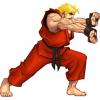To see what I want to do look at the screenshots below from a game called Facewound. Here are screenshots when running the game in 640x480 and 1024x768 window size. It is obviously the same scene, and if we count the tiles (32x32), we see that the original scene is 1024 pixels wide and it is somehow rendered to fit on just 640x480 window.
In my game if I change the screen resolution, the size of the scene that will be rendered depends on the size of the bacbuffer.So if it is 640x480, it just renders the upper left corner of the size 640x480. But I want the whole 1024x768 be rendered on 640x480 and not just the upper left part.
I am using DirectX and ID3DXSprite object to render sprites. All, I need is the idea/principle how stuff like this are made, not the code.
640x480

1024x768









